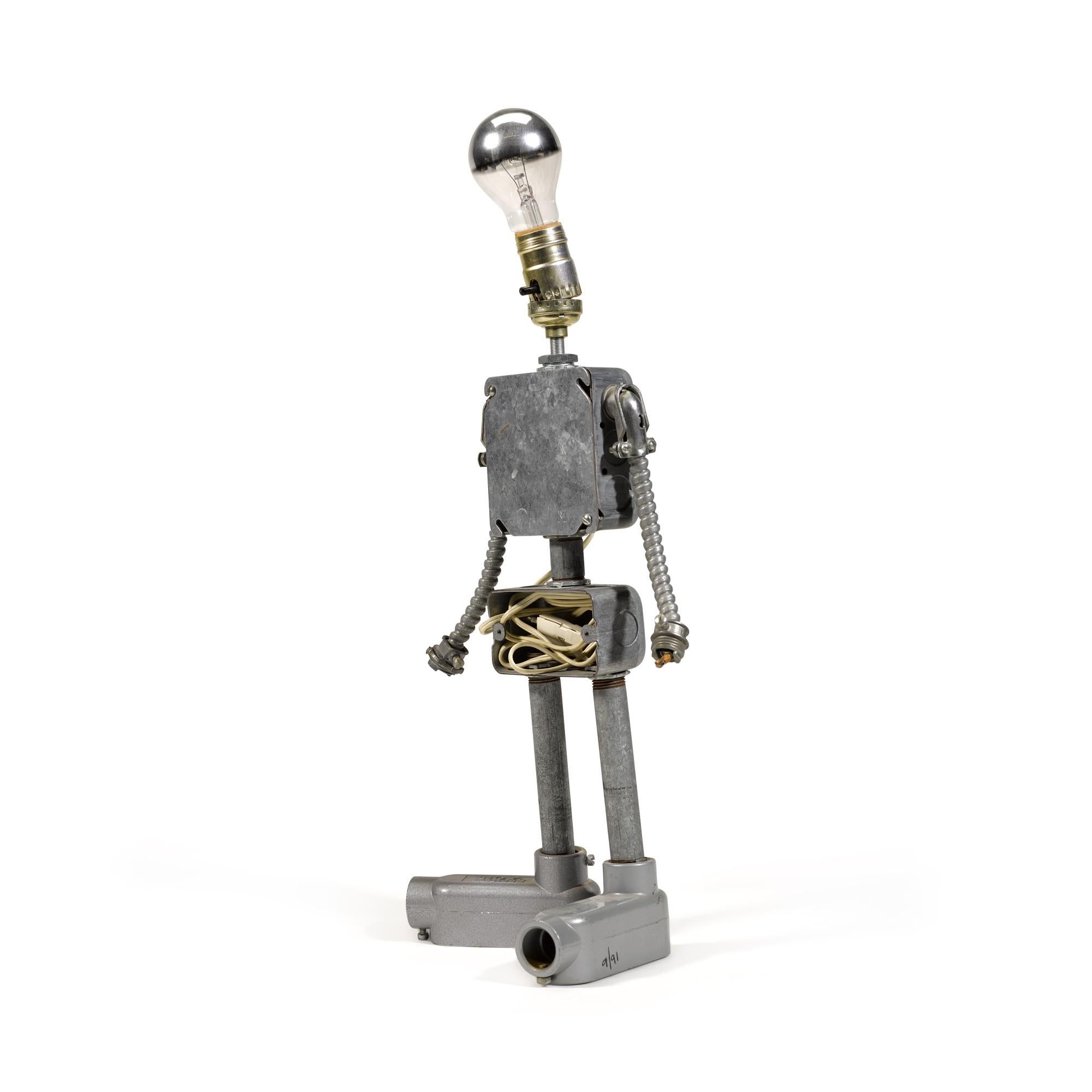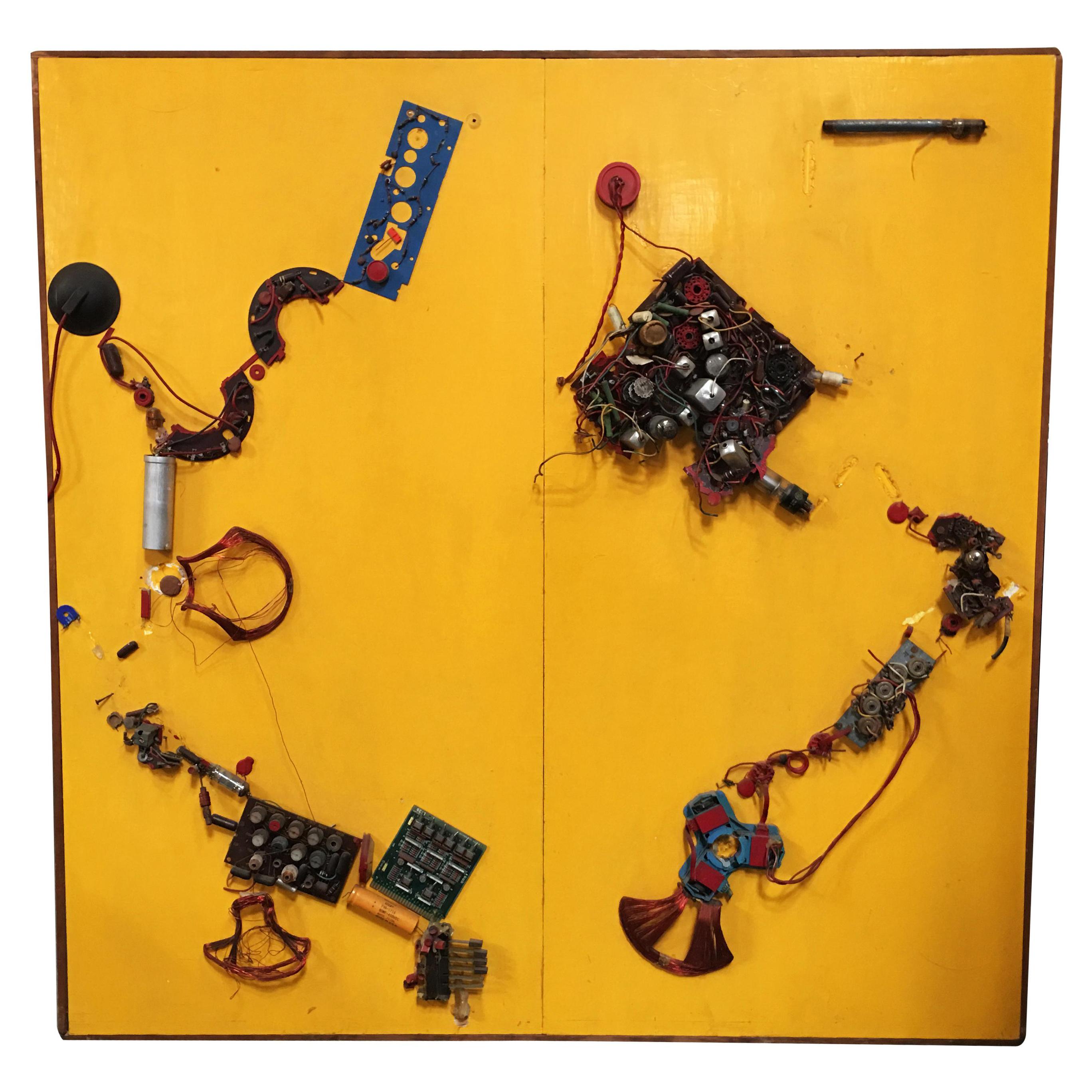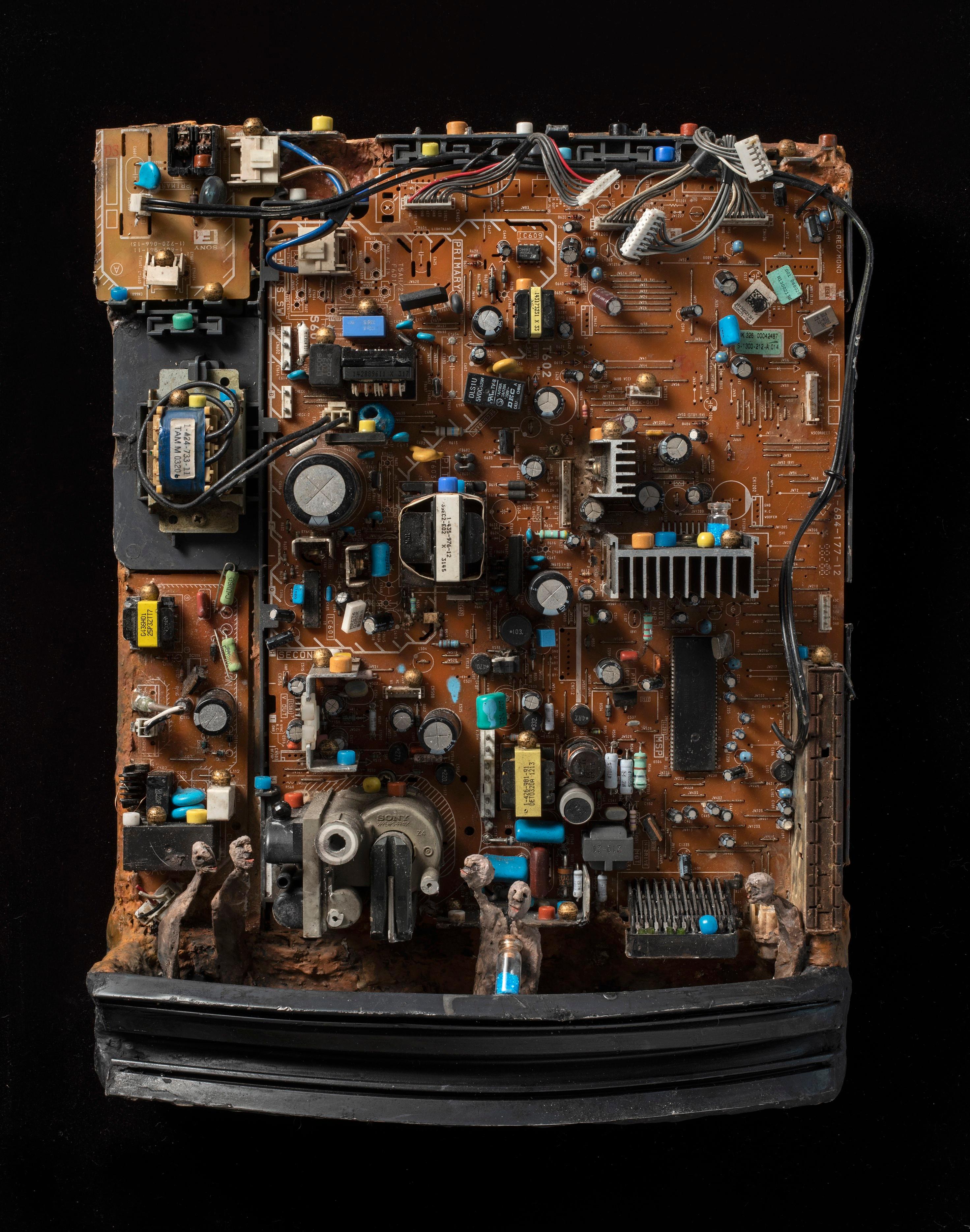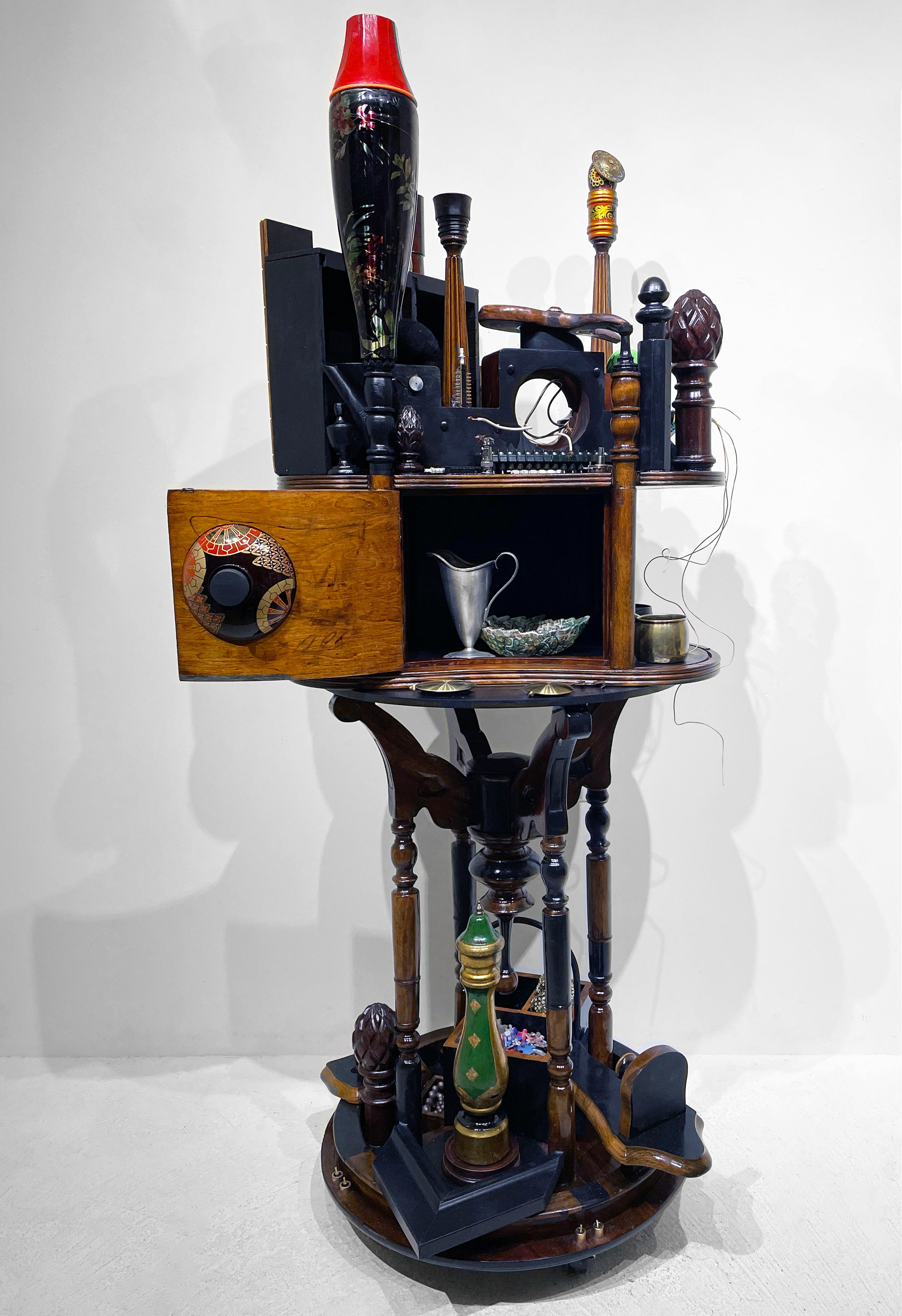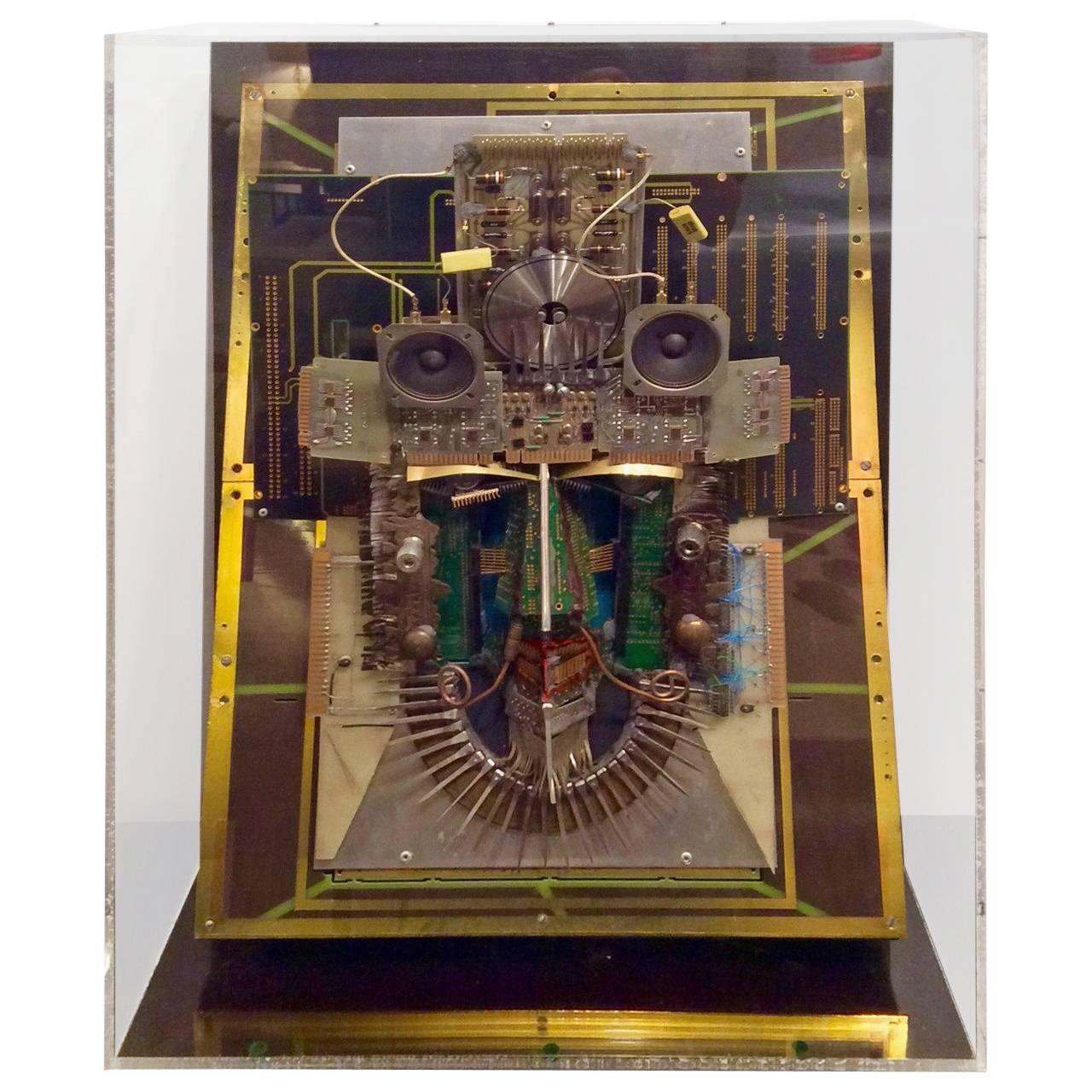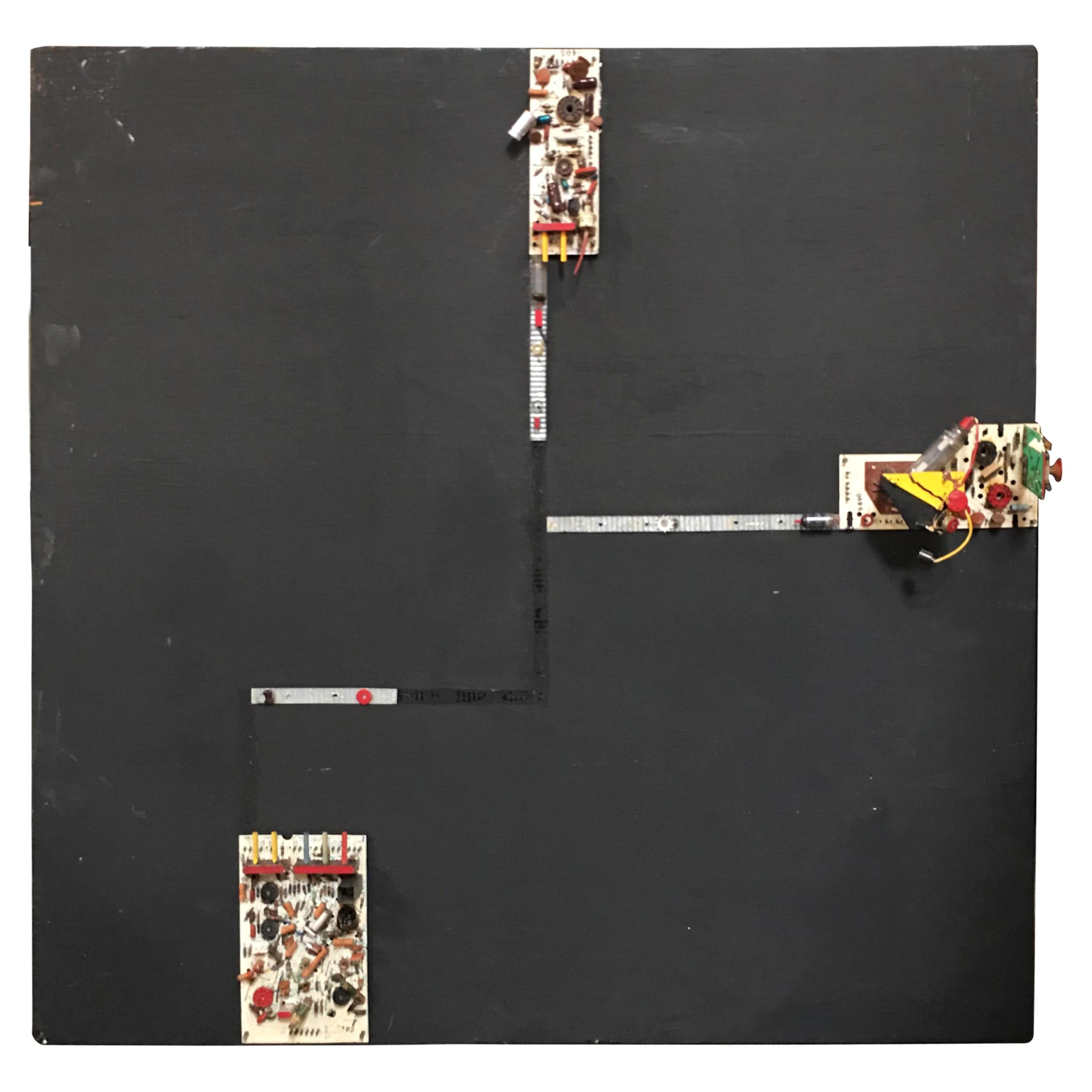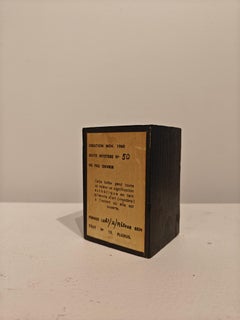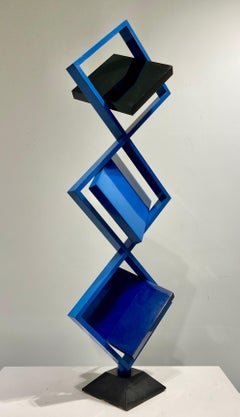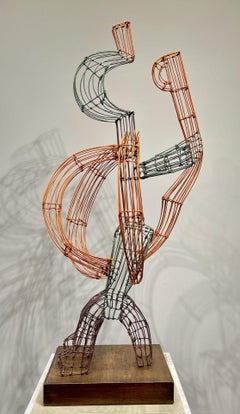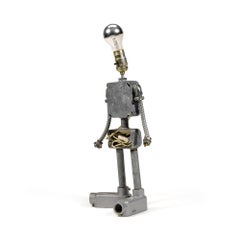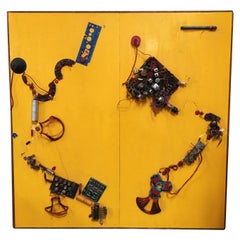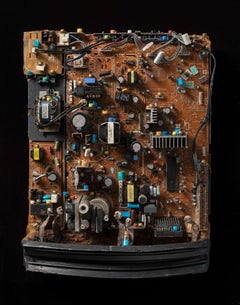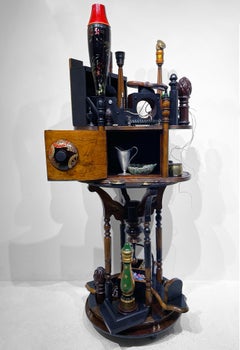Articles similaires à "Happy New Year" Nam June Paik et Charlotte Moorman, Fluxus Electric Sculpture
Vous voulez plus d'images ou de vidéos ?
Demander au vendeur plus d'images ou de vidéos
1 sur 6
Nam June Paik"Happy New Year" Nam June Paik et Charlotte Moorman, Fluxus Electric Sculpturecirca 1970
circa 1970
3 125,15 €
À propos de cet article
Nam June Paik and Charlotte Moorman
Happy New Year, circa 1970
Signed by both artists
Electronic circuit board
8 1/4 x 9 1/4 x 1 1/4 inches
Nam June Paik (1932–2006), internationally recognized as the "Father of Video Art," created a large body of work including video sculptures, installations, performances, videotapes and television productions. He had a global presence and influence, and his innovative art and visionary ideas continue to inspire a new generation of artists.
Born in 1932 in Seoul, Korea, to a wealthy industrial family, Paik and his family fled Korea in 1950 at the outset of the Korean War, first to Hong Kong, then to Japan. Paik graduated from the University of Tokyo in 1956, and then traveled to Germany to pursue his interest in avant-garde music, composition and performance. There he met John Cage and George Maciunas and became a member of the neo-dada Fluxus movement. In 1963, Paik had his legendary one-artist exhibition at the Galerie Parnass in Wuppertal, Germany, that featured his prepared television sets, which radically altered the look and content of television.
After immigrating to the United States in 1964, he settled in New York City where he expanded his engagement with video and television, and had exhibitions of his work at the New School, Galerie Bonino and the Howard Wise Gallery. In 1965, Paik was one of the first artists to use a portable video camcorder. In 1969, he worked with the Japanese engineer Shuya Abe to construct an early video-synthesizer that allowed Paik to combine and manipulate images from different sources. The Paik-Abe video synthesizer transformed electronic moving-image making. Paik invented a new artistic medium with television and video, creating an astonishing range of artworks, from his seminal videotape Global Groove (1973) that broke new ground, to his sculptures TV Buddha (1974), and TV Cello (1971); to installations such as TV Garden (1974), Video Fish (1975) and Fin de Siecle II (1989); videotapes Living with the Living Theatre (1989) and Guadalcanal Requiem (1977/1979); and global satellite television productions such as Good Morning Mr. Orwell, which broadcast from the Centre Pompidou in Paris and a WNET-TV studio in New York City Jan. 1, 1984.
Paik has been the subject of numerous exhibitions, including two major retrospectives, and has been featured in major international art exhibitions including Documenta, the Venice Biennale and the Whitney Biennial. The Nam June Paik Art Center opened in a suburb of Seoul, South Korea, in 2008.
Charlotte Moorman was an American cellist and performance artist who was a strong driving force for avant-garde music; she was dubbed the ‘Jean d’Arc of new music’ by composer Edgar Varese. In 1963, Moorman founded the Annual Avant Garde Festival in New York, which she directed for two decades.
Moorman frequently collaborated with Korean Nam June Paik over a decades-long period who was known as the ‘father of video art’. Paik created some works specifically with Moorman in mind including TV Bra for Living Sculpture (1969) and TV-Cello (1971).
Following Moorman’s death from breast cancer in 1991, Paik made a film entitled Topless Cellist (1995) about her life and avant-garde performances. Moorman also collaborated with other Fluxus artists including Carolee Schneemann, Joseph Beuys, Takehisa Kosugi and Jim McWilliams (Sky Kiss, 1968-1980).
- Créateur:Nam June Paik (1932 - 2006, Américain, Coréen)
- Année de création:circa 1970
- Dimensions:Hauteur : 20,96 cm (8,25 po)Largeur : 23,5 cm (9,25 po)Profondeur : 3,18 cm (1,25 po)
- Support:
- Mouvement et style:
- Période:
- État:
- Adresse de la galerie:New York, NY
- Numéro de référence:1stDibs : LU1841216061362
À propos du vendeur
5,0
Vendeur Platine
Vendeurs premium dont la note est supérieure à 4,7 et le délai de réponse de 24 heures maximum
Établi en 2022
Vendeur 1stDibs depuis 2022
115 ventes sur 1stDibs
Temps de réponse habituel : <1 heure
- ExpéditionRecherche du devis...Expédition depuis : New York, NY
- Politique des retours
Certaines parties de cette page ont été traduites automatiquement. 1stDibs ne garantit pas l'exactitude des traductions. L'anglais est la langue par défaut de ce site web.
Garantie d'authenticité
Bien qu'il soit peu probable que la situation se présente, dans le cas où vous rencontreriez un problème d'authenticité d'un article, contactez-nous dans un délai d'un an pour obtenir un remboursement intégral. DétailsGarantie de remboursement
Si votre article n'est pas conforme à la description, est endommagé pendant le transport ou ne vous est pas livré, contactez-nous sous 7 jours pour obtenir un remboursement intégral. DétailsAnnulation sous 24 heures
Vous disposez d'un délai de 24 heures pour annuler votre achat sans motif.Des vendeurs professionnels agréés
Nos vendeurs de renommée mondiale doivent respecter des normes strictes en matière de service et de qualité, afin de préserver l'intégrité de nos fiches produit.Garantie d'alignement des prix
Si vous constatez qu'un autre vendeur a mis en vente le même article à un prix inférieur sur un autre site, nous nous alignerons sur ce prix.Livraison en toute confiance à l'international
Notre réseau de transporteurs de premier ordre propose des options d'expédition spécialisées dans le monde entier, y compris des livraisons personnalisées.Plus d'articles de ce vendeur
Tout afficher"Boîte mystère (Mystery Box) Ben Vautier, Sculpture conceptuelle du mouvement Fluxus
Par Ben Vautier
Ben Vautier
Mystery Box (Boîte mystère), 1965
Painted wood with letterpress label
3 13/16 × 2 3/4 × 2 7/16 inches
Ben Vautier was a French artist known for his text-based paintings...
Catégorie
années 1960, Conceptuel, Sculptures - Abstrait
Matériaux
Bois, Papier
« Secret Santa » Takako Saito, construction conceptuelle du mouvement Fluxus, sculpture
Takako Saito
Secret Santa , 1965
Stamped inscribed in pen recipients name
Wood construction
1 1/2 x 1 1/4 x 1 1/4 inches
Takako Saito is a Japanese artist closely associated with F...
Catégorie
années 1960, Conceptuel, Sculptures - Abstrait
Matériaux
Bois
Sculpture constructiviste tournante Roger Phillips, 1985
Par Roger Phillips
Roger Phillips
Sculpture cinétique
Fer peint et aluminium sur socle en noyer
44 1/2 pouces de haut x 13 pouces de large x 7 3/4 pouces de profondeur
oger Phillips est né à New York...
Catégorie
années 1980, Constructiviste, Sculptures - Abstrait
Matériaux
Émail, Fer
7 143 € Prix de vente
20 % de remise
"Hitch Hiked" Oubre Hayward, sculpture en fil de fer peint, artiste noir du Sud
Hayward Oubre
Hitch Hiked, 1960
Signé sur la base : OUBRE 60
Sculpture en fil de fer peint
45 H. x 21 L. x 19 P. pouces
Provenance :
Succession de l'Artistics
Profondément attaché ...
Catégorie
années 1960, Sculptures - Figuratif
Matériaux
Fil de fer
"Monument 8" Calvin Marcus, construction mixte Sculpture contemporaine
Calvin Marcus
Monument 8, 2018
Bois, verre, colle chaude, carton, plastique, pâte à papier, soufre, cendre, gesso, Cel-Vinyl, flashe, aquarelle et autres techniques de sculpture.
22"...
Catégorie
années 2010, Contemporain, Sculptures - Figuratif
Matériaux
Verre, Plastique, Bois, Papier, Colle, Technique mixte, Aquarelle, Carton
8 571 € Prix de vente
20 % de remise
« Moon » Ray Johnson, technique mixte minimaliste sur massonite, mouvement Fluxus
Par Ray Johnson
Ray Johnson
Lune
Technique mixte sur Masonite
8 3/4 x 6 1/2 pouces
Autrefois décrit comme "l'artiste inconnu le plus célèbre de New York", Ray Johnson était un créateur renommé de ...
Catégorie
années 1960, Conceptuel, Technique mixte
Matériaux
Massonite, Technique mixte
Suggestions
Robot
Par Nam June Paik
Multiple en métal mixte avec ampoule, 1990, signé à l'encre noire, daté, numéroté d'une édition de 91 œuvres uniques, publié par Edition Mönchehaus-Museum, Goslar, Allemagne, hauteur...
Catégorie
années 1990, Moderne, Sculptures - Figuratif
Matériaux
Métal
21 902 €
« Radio Tronics » - Artographie abstraite - Sculpture en techniques mixtes Lrg de Pasqual Bettio
Par Pasqual Bettio
Sculpture murale Artography intitulée "Radio Tronics" Sculpture murale Artography de Pasqual Bettio. Bio Senior Senator ret. J. Pasqual Bettio F.R.P.S. a commencé sa carrière artisti...
Catégorie
Vintage, années 1980, Américain, Sculptures murales
Matériaux
Bois
8 625 € Prix de vente
31 % de remise
Sculpture murale Outsider Art : « Fabriquée électrique »
Par Gerard Cambon
Gérard Cambon est né en 1960 à Toulouse (Fr).
Il est diplômé en sciences politiques et est un artiste autodidacte.
Dans les premières années de sa vi...
Catégorie
années 2010, Outsider Art, Sculptures - Figuratif
Matériaux
Métal
Linda Stein, Favorites 1232 - Art contemporain - Sculpture d'assemblage en techniques mixtes
Cette œuvre de la série Displacement From Home de Linda Stein s'inspire de la tradition des wunderkammer/cabinets de curiosités pour mettre en lumière le déplacement global et la mém...
Catégorie
années 2010, Contemporain, Sculptures - Abstrait
Matériaux
Métal
32 144 € Prix de vente
20 % de remise
Sculpture unique d'anciens ordinateurs de George Dergalis 1988
Par George Dergalis
Une sculpture murale unique et signée, composée de vieilles puces et de matériel informatique. Il est logé dans un cadre en Lucite. Il est daté de 1988.
Il y a quelques pièces manqua...
Catégorie
Vintage, années 1980, Américain, Sculptures murales
Sculpture abstraite en technique mixte « My First Tronic » de Pasqual Bettio
Par Pasqual Bettio
Sculpture murale Artographie intitulée "Mon premier Tronic" Sculpture murale Artographie de Pasqual Bettio.
Bio
Le sénateur senior retraité J. Pasqual Bettio F.R.P.S. a commencé ...
Catégorie
Vintage, années 1980, Américain, Sculptures murales
Matériaux
Bois
8 625 € Prix de vente
31 % de remise
